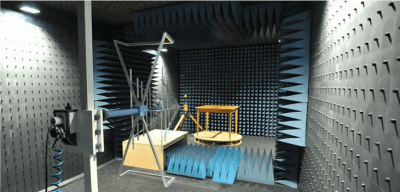
Copper Mountain Technologies' 808/1 Vector Network Analyzer Field-Tested at the Hamburg University of Applied Science
July 9, 2018The Hamburg University of Applied Sciences is one of the larger technical universities in Germany. Over 1000 students study in the field of Electrical and Information Technology. In the Laboratory for Communication Technology, under the guidance of Prof. Ralf Wendel, training in the field of RF and Microwave Technology takes place. Students from the Electrical and Information Technology bachelor’s curriculum as well as the master’s program, Information and Communication Technology, participate in application of learned principles.
The Laboratory for Communication Technology is well equipped with network and spectrum analyzers, signal sources up to 20 GHz, an antenna measuring station for the characterization of antennas from 700 MHz, an anechoic chamber of dimensions 3.2 x 3.5 x 7 m for the implementation of electromagnetic compatibility (EMC) tests for radiation and immunity; as well as testing stations for burst and surge electrostatic discharge characterization.

This abundance of state-of-the-art measuring equipment and facilities promotes the education of all involved students, who learn the design of RF and microwave components in coursework and become familiar with the basics of EMC in application. The students can measure their self-designed components and develop a sense of high-frequency, electromagnetic wave behavior.
A large computer pool with 3D field calculation software from CST Simulation and AWR Microwave Office from National Instruments is available for simulation of designs. The Laboratory for Communication Technology allows for joint master and bachelor thesis projects and cooperations with external partners.

About one year ago we added an 808/1 from Copper Mountain Technologies (CMT), a 4-port, 8 GHz VNA. The price of the analyzer is favorable and both cables and calibration kits are available for purchase with this equipment. Comparison of technical specifications from different providers showed no significant differences. For use in the classroom, high flexibility and user-friendliness are important. The 808/1 ensures this with its low weight and compact dimensions.
With this device it is convenient to demonstrate a measurement on the blackboard in the context of a lecture, or to quickly place the device at the workplace of a student. Students can install the software on their own laptop to save device settings and read out data for further processing instantly. In addition, the menu navigation is well structured and easily understood.
The 808/1 is regularly used in the classroom. For example, in the bachelor’s course High-Frequency Electronics, a coupler is analyzed using field calculation software. For the first time in our lab, the accuracy of this simulation could be verified with a single, 4-port measurement.
As part of the master’s course High-Frequency and Microwave Technology, a radar module is designed and built. It was possible to record all scattering parameters of a Wilkinson Power Divider in one process. The 808/1’s two signal sources were also used to test the broadband mixers.
Another master’s course, Radio Technology and Wireless Networks for the Internet of Things, involves integration of antennas into small radio modules; and now simu ltaneous communication via two integrated antennas could be characterized.
ltaneous communication via two integrated antennas could be characterized.
In addition to elevating coursework, the 808/1 also enriches the field of applied research. For example, the device is used for measurement of reflection and transmission properties of materials in our anechoic chamber. Here, the time domain and gating functions included with the 808/1 allow us to measure the reflection from the antennas so that their influence can be calculated out. Filters were used to compare this model to Vector Network Analyzers from other manufacturers and there were no significant differences in the measured curves and in the measurement time.

Implemented microwave components of a radar module
The device’s dynamic range was not fully exploited in our lab by allowing longer measurement times. If the IF bandwidth setting was low or the number of points was high – the CMT VNA will update the display very slowly. This took a bit of getting used to.
Smaller support requests for the 808/1 were made directly to Copper Mountain Technologies’ USA office, via e-mail. These were answered satisfactorily within a single day. Overall, the purchase has so far met all expectations, especially given the good price to performance ratio.
Author: Prof. Dr.-Ing. Ralf Wendel, Labor für Kommunika- tionstechnik, Berliner Tor 7, 20099 Hamburg


